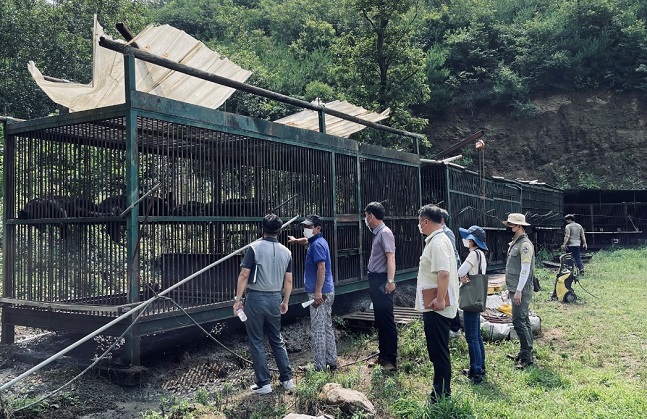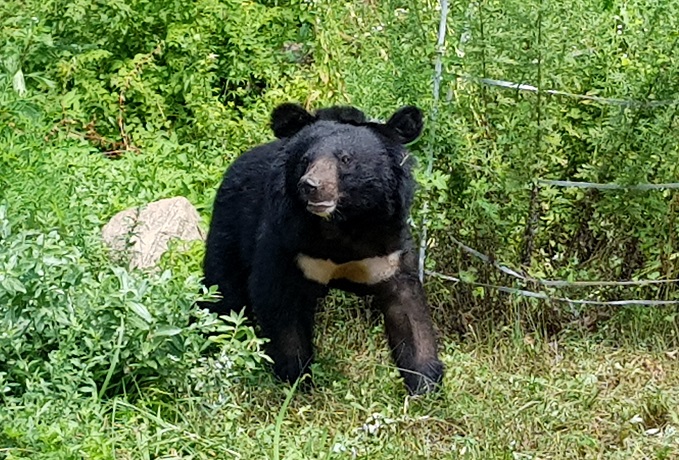
Officials inspect a bear farm in Yongin, South Korea, on July 8, 2021 in this photo provided by the Yongin city government. Two 3-year-old bears escaped from the farm two days earlier. (Yonhap)
SEOUL, July 10 (Korea Bizwire) — Early this week, two young bears escaped from their cramped cages at a breeding farm in Yongin, south of Seoul.
One was shot to death hours after the escape, and the other is still on the loose.
Similar incidents have occurred in the past in a country where bears — mostly moon bears, or Asiatic Black Bears, on the endangered species list — are kept captive for life for their bile and other body parts that are used in alternative medicinal treatments.
The owner of the farm, according to environmental advocacy group Korean Animal Association, operates one more farm in the nearby city of Yeoju and keeps a total of 100 bears in tiny cages in inhumane conditions.
The group reported the farm’s owner to police in June last year for illegal breeding, extraction of bile and butchering bears for meat. The owner was later given a four-month sentence, which was suspended for a year.
“The farm shows the glaring reality of the country’s bear farming industry, a breeding ground for illegal activities. No action was taken to improve the living conditions (for bears) despite repeated cases in which the animals ran off from farms,” Green Korea United, another advocacy group, said in a statement.
The group criticized the government for its disregard for animal welfare and insufficient inspection and oversight of the industry.
South Korea is one of a few countries in the world that still allow bear bile farming.
The country started to encourage breeding and exporting bears in 1981 as a way to help increase income for poor farmers.
But a year later, moon bears became endangered species designated under the Convention on International Trade in Endangered Species of Wild Fauna and Flora (CITES).
In 1985, the country caved into international pressure and banned export of moon bears, and decided to fully comply with the CITES in 1993.
Facing strong opposition from bear farmers, however, the government legalized the killings of caged bears at age 10 or older for bile extraction. With the decision came the lifelong suffering of the furry creatures.
In order to reduce the number of captive bears, the Ministry of Environment financially supported farmers to have their bears sterilized.
From 2014 to 2017, 967 bears were sterilized and the number of the nation’s caged bears has fallen to around 400, from approximately 1,400 in mid-2020, according to the groups.

A moon bear appears at a farmhouse in Ulsan, South Korea on May 19, 2021, in this photo provided by the city’s fire agency.
But animal welfare advocates say that illegal breeding is still going on, as there is demand for bile, and that the government should take on a more active role in ending their suffering.
They suggest the government build a sanctuary — like in Vietnam and Cambodia — to keep the bears in a safe place until they meet their natural deaths.
The public were found to be supportive of the idea. According to a survey done on 1,500 adults in 2019, nearly 86 percent of the respondents agreed with the need to end the plight of caged bears and to build a sanctuary for them.
And more than 79 percent said the government should play a crucial role in improving their welfare.
A step to improve the lives of abused bears has been taken, albeit slowly.
In February, the environment ministry announced that it will build a 24,000-square-meter sanctuary in Gurye, a county in South Jeolla Province, by 2024.
The move is “a step closer to the protection of captive bears that activists have been calling for over the past decade,” the Korea Animal Rights Advocates (KARA) welcomed in March.
“But there are still concerns about the welfare of 407 caged bears left in neglect and indifference,” the group said, calling on the ministry to come up with measures to save them from their cages and to openly discuss future plans with activists.
(Yonhap)







